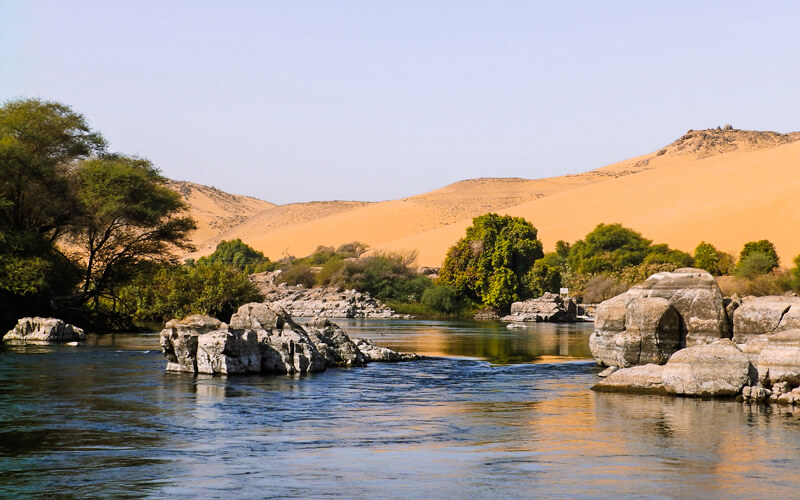
Several pre-dynastic artifacts were discovered on Elephantine Island, proving that the island’s history goes back to that era. Throughout history, this spot has been ideal for those looking for a location to protect themselves that was difficult to get to. The island’s southern section has a lengthy history of being a stronghold.
Cambyses II, the son of Cyrus the Great and the king of Persia, ordered the destruction of these structures between 525 and 522 B.C. These structures were razed to the ground by order of Cambyses II. Both the temple to Khnum and the famous Nilometer used to measure the height of the Nile remain today.
Mango and papaya trees thrive in the tropical climate of Elephantine’s many palm groves and tiny farms. It is a little town with houses no higher than two floors, painted a bright blue on the exterior, and streets so narrow that two donkeys could not pass each other. Garbage and damp grass fills the air while raucous clucking chickens and cock-a-doodle-doos can be heard from surrounding backyards.
Meaning of Elephantine:
What the island has to offer They were all murdered in the campaign commanded by Mehemed Ali, the sultan’s administrator of Egypt. The earliest temple, also known as the Temple of State, was constructed in 3000 B.C.
The temple’s remains to Khnum occupy much of the island’s southern half. These ancient structures were constructed using the same third-dynasty limestone to build the step pyramid. A minor temple was erected in the area during the sixth dynasty, during the leadership of Hegaib, and this structure is still extant.
About The Island:
The island’s moniker, “Elephant Island,” may have originated from one of two distinct causes. Aesthetically, it resembles an elephant’s tusk, and the spherical stones that line its beaches are sometimes mistaken for tusks as well. The ancient Egyptian term “Elephant,” “Ab,” or “Abu” is the source of the modern-day name “Elephantine,” which was formerly known as “The Island of Flowers” among the Arabs.
Location:
While Aswan is located downstream from the first waterfall in the Nile’s cascade, Elephantine is situated upstream. It is the largest island in its vicinity, and all the others are much smaller. Thanks to its advantageous location, it played a significant role throughout the Pharaonic era and even into the late Hellenistic period. It’s a geographical landmark that was formerly used for road protection in southern Egypt.
This is because it is on a geographical border that formerly acted as a watchtower for the trade routes connecting southern Egypt. Since it is the administrative center of the Upper Egyptian nome, Elephantine has its triad. Many temples were constructed there to honor the gods Khnum, State, and Anuket, but now only their foundations and a few ruins remain.
Temple of Khnum:
The Nilometer is widely regarded as one of the most significant structures of the Khnum Temple. To gauge and record the severity of the Nile River floods, Elephantine played a crucial role. During the reign of Ptolemy III Euergetes, a Greek astronomer named Eratosthenes used its coordinates to calculate Earth’s circumference, and these findings were gathered here.
During the reign of the Ptolemies, the cult of the goddess Isis on the island of Phyle flourished. As a result, Aswan and its surrounding region grew in significance as a religious hub throughout antiquity. Elephantine temples were expanding during the first and second century A.D.
In 298 AD, however, with the Roman Empire in disarray and the Blemians of the eastern desert launching frequent incursions, Diocletian had little choice but to abandon the frontier at Aswan. When Theodosius ordered all of the temples in the empire to be shut down in 391, however, the people of Philae ignored his order. However, a struggle broke out between Roman and Nubian officials when they sought to shut down the temples.




